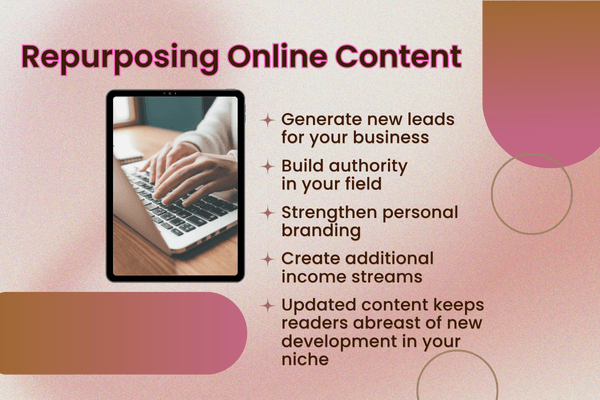How to Repurpose Old Content for New Organic Traffic Opportunities
Let’s face it, creating new content can be time-consuming and resource-intensive. But what if I told you there’s a goldmine sitting right under your nose? Your old content, the blog posts and articles you’ve already poured your heart into, holds immense potential to drive new organic traffic. When you repurpose old content, you can give it a fresh lease on life and make it work harder for you.
To repurpose old content isn’t just about recycling ideas; it’s about strategically transforming them to meet current trends and audience needs. This approach not only saves time but also maximizes the value of your existing content library.
Why Repurposing Old Content Works
To repurpose old content is like giving your wardrobe a makeover. You already have the essentials, and now it’s about styling them in new and exciting ways. The digital landscape is constantly evolving, and your content should evolve with it. By updating and repurposing, you can keep your content relevant and engaging.
Search engines love fresh content, and repurposing allows you to update your old material with new keywords and information. This process can significantly improve your SEO, helping your content rank higher and reach a broader audience.
Tapping Into High-Performing Posts
Not all content is created equal. Some of your posts will naturally perform better than others. These high-performing pieces are your secret weapon when it comes to repurposing. Why? Because they’ve already proven their value by attracting traffic, generating engagement, or leading to conversions.
Start by identifying these top performers. Look at your analytics to see which posts have consistently high traffic or engagement rates. These are the posts that resonate with your audience, making them perfect candidates for repurposing.

Extending the Life of Previous Work
Your existing content has a lot more to offer than you might realize. When you repurpose old content and extending its life, you can continue to reap the benefits of your past efforts without having to start from scratch. This not only saves time but also stretches your content budget further.
Picking Content to Refresh
When deciding which content to refresh, consider its relevance and potential for updating. Ask yourself if the topic is still pertinent to your audience. If it addresses a timeless issue or question, it’s a great candidate for repurposing.
Additionally, look for content that has generated backlinks or led to conversions. These pieces have already demonstrated their effectiveness, so updating them with new information or a fresh perspective can further enhance their impact.
Using Analytics to Identify Opportunities
Analytics are your best friend when it comes to repurposing content. By diving into your data, you can uncover hidden gems that are ripe for refreshing. Look for posts with high traffic but low conversion rates. These are opportunities to tweak and optimize for better performance.
Similarly, identify content that has been shared widely on social media. These posts clearly resonate with your audience and can be repurposed to maintain their momentum.
Incorporating New and Relevant Keywords
Keywords are the backbone of SEO, and to repurpose old content with new and relevant keywords, can breathe new life into it. Start by researching current trends and popular search terms within your niche. Use tools like Google Keyword Planner or SEMrush to identify keywords that have high search volume and low competition.
Once you’ve identified these keywords, weave them naturally into your content. Avoid keyword stuffing, as this can harm your SEO rather than help it. Instead, focus on integrating keywords into headings, subheadings, and throughout the text where they fit organically.
Besides adding new keywords, consider updating your meta descriptions and alt tags with these terms. This comprehensive approach ensures that your content is optimized for search engines, increasing its chances of being discovered by a wider audience.
Redefining Content Formats
Sometimes, the format of your content can limit its reach. By transforming your content into different formats, you can tap into new audiences and platforms. For example, a detailed blog post can become an engaging video or a visually appealing infographic.
Consider the preferences of your audience when choosing a format. Younger audiences might prefer video content, while professionals might appreciate a well-designed infographic. By diversifying your content formats, you can ensure that your message reaches the right people in the right way.
Transforming Posts into Videos or Infographics
Videos and infographics are powerful tools for engaging audiences. A blog post packed with data and statistics can be transformed into an eye-catching infographic that highlights key points visually. This not only makes the information more digestible but also more shareable on platforms like Pinterest and Instagram. For more insights, check out this guide on repurposing content.
Similarly, turning a blog post into a video can attract viewers who prefer watching over reading. Use platforms like YouTube to host your videos and embed them in your blog to enhance user experience. Adding transcripts or captions can also improve accessibility and SEO.
Breaking Down Long Articles for Social Media
Long-form content is great for in-depth exploration of a topic, but it doesn’t always perform well on social media, where brevity is key. Consider breaking down lengthy articles into bite-sized pieces that can be shared as a series of posts on platforms like Twitter or LinkedIn.
Each post can focus on a specific aspect of the topic, encouraging engagement and discussion. This strategy not only increases your content’s visibility but also keeps your audience engaged over a longer period.
Leveraging Content for Diverse Platforms
When you repurpose old content for different platforms allows you to reach audiences where they are most active. Each platform has its unique characteristics and audience preferences, so tailor your content accordingly.
Social Media Strategy Revamp
Social media is a dynamic landscape, and your strategy should evolve with it. Use repurposed content to refresh your social media presence. Share snippets of updated blog posts, infographics, or videos across your social channels to maintain a steady stream of engaging content.
Integrating into Email Campaigns
Email marketing remains one of the most effective ways to reach your audience directly. Repurposed content can be a valuable addition to your email campaigns. Use it to provide value to your subscribers, whether through informative newsletters or exclusive content offers.
For instance, a comprehensive guide or series of blog posts can be repackaged into an eBook that you offer as a lead magnet. This not only drives engagement but also helps grow your email list.
Republishing on Guest Blogs
Guest blogging is an excellent way to reach new audiences and build backlinks to your site. Consider offering repurposed content to other blogs within your industry. Tailor the content to fit the host blog’s style and audience for maximum impact.
Ensure that when you repurpose old content for guest blogs, it is unique and offers value. This will enhance your credibility and encourage readers to visit your site for more insights.
Repurposing old content is not just about recycling; it’s about reinvention. By leveraging your existing content in new ways, you can maximize its value and reach a broader audience. For a comprehensive guide on this topic, check out Buffer’s guide on repurposing content. Remember, the key is to keep your content fresh, relevant, and engaging.
Closing Thoughts and Next Steps
To repurposing old content is undoubtedly a powerful strategy that allows you to breathe new life into your existing work. By updating, transforming, and diversifying your content, you can reach new audiences and enhance your SEO efforts. It’s not just about recycling; it’s about strategically maximizing the potential of what you already have.
As you embark on this journey, remember that the key is to maintain relevance and provide value to your audience. Whether it’s through updating information, incorporating new keywords, or exploring different content formats, each step you take will contribute to your content’s success.
Emphasizing How to Start Immediately on Repurposing
To start repurposing your content right away, begin by auditing your existing library. Identify high-performing posts and assess their current relevance. Use analytics to pinpoint opportunities for improvement and optimization. Then, set a plan to update and transform these pieces into formats that will engage your target audience effectively.
Don’t hesitate to experiment with different platforms and formats. The digital landscape is vast, and there’s a perfect place for your content to shine. Most importantly, stay consistent and committed to delivering quality content that meets the needs of your audience.
Repurpose Old Content – Frequently Asked Questions
Repurposing content can raise several questions, especially if you’re new to the process. Here are some common inquiries and their answers to guide you on your repurposing journey.
What Benefits Can I Expect from Repurposing Old Content?
Repurposing old content offers numerous benefits, including increased organic traffic, improved SEO rankings, and extended reach across different platforms. By updating and transforming your content, you can attract new audiences, enhance engagement, and maximize the value of your existing resources.
Additionally, repurposing saves time and resources by leveraging work you’ve already done, allowing you to focus on other aspects of your content strategy.
How Often Should I Update My Content?
The frequency of updates depends on your content’s nature and relevance. For evergreen content, consider revisiting it every six months to a year. If your content covers rapidly changing topics, more frequent updates may be necessary to maintain accuracy and relevance. For more insights, you can explore this guide on repurposing content.
Can Repurposing Old Content Negatively Impact My SEO?
When done correctly, repurposing old content should enhance your SEO efforts. However, it’s essential to avoid duplicate content issues by ensuring each piece is unique and offers value. Focus on updating information, incorporating new keywords, and transforming content formats to maintain SEO integrity.
Which Content Formats Deliver the Best Results?
The best content formats depend on your audience and goals. Videos and infographics are highly engaging and shareable, making them ideal for reaching broader audiences. Blog posts and articles are excellent for in-depth exploration, while social media posts and emails are perfect for quick engagement and direct communication.
How Do I Decide Which Content to Repurpose First?
Start by identifying high-performing content that has attracted significant traffic or engagement. Use analytics to determine which pieces have the most potential for improvement. Focus on topics that are still relevant to your audience and have room for updates or transformation.
Once you’ve identified these pieces, prioritize them based on their potential impact and ease of repurposing. By taking a strategic approach, you can maximize the benefits of your repurposing efforts and achieve your content marketing goals.
Repurpose Old Content – Concluding Insights
- To repurpose old content can increase organic traffic by targeting new keywords and reaching broader audiences.
- High-performing posts are ideal candidates for repurposing due to their proven appeal and engagement.
- Updating old content with current information boosts its relevance and search engine ranking.
- Transforming content into different formats, like videos or infographics, enhances its reach.
- Using analytics helps identify the best content to repurpose for maximum impact.

Knowing how to repurpose old content for new organic traffic opportunities, is is a method that is often overlooked, although it forms part of the the lifeblood of modern marketing. But mastering it requires more than just guesswork—it demands a highly focussed strategic approach that spans across multiple platforms. Video, podcasts, blogs, infographics, and press releases each play a vital role in distributing your message far and wide, and often it only requires the repurpose of old content to encapsulate latest trends that are impacting developments within the specific niche within which you operate.
At OneStopSolutions we’ve distilled years of expertise into a comprehensive guide designed to help you dominate multichannel organic traffic. This resource will walk you through proven tactics to create high-impact content that resonates with your audience and boosts search engine rankings. Ready to take control of your organic growth? Visit OneStopSolutions and engage with the experts, explore the free resources and then start implementing strategies that drive real results. Do not miss out on the opportunity to stay ahead of the curve and surpass your competitors with simple yet highly effective strategies that many oof them are neglecting to implement.
